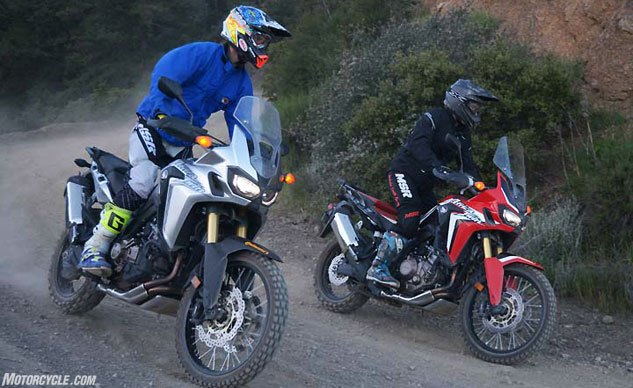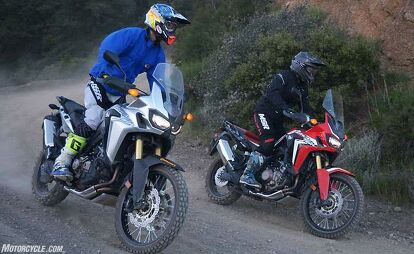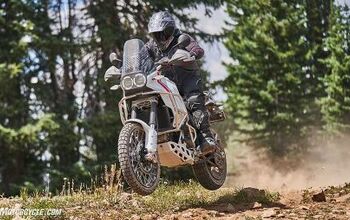Honda Africa Twin Shootout: DCT Vs. Manual Transmission
Twin on Twin action to determine the preferred gearbox
Honda currently offers two versions of the Africa Twin, one with a standard six-speed manual transmission and clutch, and the other with an innovative Dual Clutch Transmission (DCT) that offers two auto-shift riding modes as well as a manual-shift mode. The DCT version retails for $13,999, or $700 more than the $13,299 standard Africa Twin.
So which Africa Twin is better: the DCT or the manual?
The DCT is not new. The concept has been incorporated into select Honda streetbike models for the past several years, first debuting on the 2010 VFR1200, but the Africa Twin marks the first time that the DCT’s mettle has been tested in a motorcycle built for use off-road as well as on the street. We’re sure it won’t be the last.
Whether it’s equipped with a standard transmission or a DCT, the Africa Twin’s rumble is supplied by a fuel-injected, 998cc parallel-Twin with a bore and stroke of 92mm x 75mm, a 270-degree crankshaft and Unicam cylinder heads with four valves per cylinder. Honda claims the relatively compact engine produces 93.9 crank horsepower at 7500 rpm, and 72.3 lb.-ft. of torque at 6000 rpm. That’s believable. During dyno testing of the standard transmission model during our 2016 Wire-Wheel Adventure Shootout, the Africa Twin delivered 85.7 rear-wheel horsepower at 7600 rpm and a peak rear-wheel torque figure of 67.0 lb.-ft. at 5900 rpm.
We had intended to put the two Africa Twin test samples on the dyno to see what the power and torque differences might be between the standard and DCT models, but that attempt was foiled when we threw the DCT model on first and found that it would not shift out of first gear no matter what mode we tried. The culprit? The DCT model has a front wheel speed sensor that helps to tell the DCT when to shift, and the front wheel must be spinning in order for that data to be gathered. So, no DCT dyno numbers.
But our sense both on the street and out on the trail is that there is little discernible difference in the power character of the two models. If anything, the DCT feels a little punchier from a standing start on the street, although this may have to with the fact that after you press the D button on the right switchgear, its drivetrain is already engaged when you rap the throttle, a sensation that may be slightly muted as the rider slips the clutch to come away from a standstill.
Otherwise, they perform almost identically, and they feel great. The Africa Twin’s parallel-Twin is the epitome of user-friendliness, delivering excellent throttle response and perhaps the smoothest transition from bottom to top of any large-displacement Adventure bike in its class. But while the Honda engine is so linear, it’s no frou-frou scooter motor. It actually delivers a mellow dirtbike-style power feel and a surprisingly hearty exhaust note while remaining virtually vibration-free and extremely tractable. Then there is also the switchable Honda Selectable Torque Control feature, which offers three levels of traction-controlling intervention that can also be disabled completely (although you have to disable it again every time you turn the key back on). The Africa Twin’s six-speed manual transmission and cable-operated clutch shift in typical Honda fashion, “like butta.”
The goal here, however, was to determine whether the Africa Twin’s DCT transmission would be a help or a hindrance, especially when ridden in rugged off-road conditions. To guarantee the right environment, we fitted each model with Continental’s world-class TKC-80 adventure tires and then loaded them up and made the seven-hour trek to Gold Point, Nevada, to enjoy the annual AltRider Taste Of Dakar Adventure Ride.
The DCT is claimed to enhance smoothness and efficiency from gear to gear by essentially engaging the next gear while the current gear is still in use. Honda says that this minimizes the power gaps that occur during shifting with a manual transmission. True to its name, the Dual Clutch Transmission features two clutches: one for off-the-line acceleration and first, third and fifth gears, and the second clutch for second, fourth and sixth gears. Honda likes to note that since clutch operation is not required, the rider is free to focus on operating the throttle and brakes.
On the street and in the dirt, we found the DCT’s Drive and Sport modes to simply not fit our own performance-seeking tastes, but that doesn’t mean they don’t work as advertised. The Drive mode delivers smooth, full-auto shifting from gear to gear for the best possible fuel economy, while Sport mode holds the Africa Twin in gear longer between shifts for a sportier riding experience. Both modes also allow the rider control of the shifting via the “paddle switches.” However, switching to full manual mode allows the DCT to stay in one gear and, when directed, to shift more quickly. And, if the rider rolls off the throttle before toggling the upshift button with his index finger, the gear change feels almost the same as a manual clutch that is engaged and released.
Still, dirt testing the DCT Africa Twin against the manual transmission version produced a difference of opinion among our two test riders as to which one works better. Along for the ride was independent motorcycle industry marketing and PR man Scott Shaffstall, an experienced off-road rider and certifiable sand dune freak. A self-proclaimed rider-active rider, Shaffstall had reservations about the DCT’s dirt-worthiness.
“If there is one area where the DCT most notably lacked in my opinion, it was acceleration responsiveness,” Shaffstall said. “I know Mr. Rousseau will disagree, but unless you want to constantly downshift with the paddle shifters, there did seem to be a lack of power in the powerband on the DCT. More experienced riders may adjust to this easily, but novices and intermediates may face a steeper learning curve. It’s great that you can downshift on demand, but relying on the DCT to automatically upshift is something I don’t prefer.”
To which I responded, “Yeah, I get that, especially after I climbed on the standard-transmission model and quickly realized by the slack clutch lever how much Shaffstall had been fanning the clutch like he probably does on his personal Honda CRF250R. It just goes to show you how much dirt riders rely on the clutch, maybe to a fault, to keep their bikes moving forward without having to shift them as much.”
That’s the beauty of the DCT. I can upshift and downshift with the click of a button for one corner or obstacle and then just as quickly shift back to the gear I was in before that. Sure, you can use Sport mode semi-effectively while riding off-road, but it never seems to shift exactly when you want it to because it simply cannot see the terrain that you are seeing. I think that the DCT in full manual mode makes it easier to be in the right gear for the obstacle or the terrain ahead at all times. That said, I certainly have no issues with the standard transmission model because, well, it’s standard.
If there is one gripe about the DCT’s pushbutton shifter location, it is that it easy to accidentally activate the turn indicator when downshifting.
During the Taste of Dakar ride, Shaffstall claimed that there is a difference in handling between the two bikes. Granted, the DCT weighs in at 536 lbs., nine more than the manual model we were testing with an accessory centerstand and taller windscreen fitted (Honda says the difference is 23 pounds), but the weight distribution is about equal. The DCT places 272 lbs. (50.75%) on the front wheel and 264 lbs. (49.25%) on the rear wheel, whereas the manual transmission Africa Twin checks in at 527 lbs., with 268 lbs. (50.85%) on the front wheel and 259 lbs., (49.14%) on the rear wheel. The two versions share an identical steel semi-double cradle type with a steel rear sub-frame and 62.0-inch wheelbase. Still, in the dirt, Shaffstall had issues with the DCT’s cornering tendencies.
“Overall, both models handled well in the dirt, but the manual was easier to control, even with Honda saddlebags it had on it,” he said. “The Continental TKC-80s proved their worth time and time again with good bite and minimal wheelspin. A steering stabilizer would have been useful in deep sand (maybe I wouldn’t have crashed). Call me old-fashioned, but I just like a clutch, and felt I could push the manual Africa Twin much farther and faster.”
I, on the other hand, saw it differently. I really noticed no difference in the way the two bikes carve or travel in a straight line. Yes, you will shift the DCT more to keep the bike in the rev range you want so immediate power is on tap, but it’s just so easy to get comfortable with that. There’s no fumbling around for the gearshift lever before putting your left leg out to stabilize yourself in a loose corner, which saves time. Both versions exhibit an excellent, well-planted cornering character, which I will agree was helped by the more aggressive Continental tires in the dirt – they really are awesome skins.
Steering is far from deliberate, even for 520ish-pound Adventure bikes. They steer with precision and with minimal effort at slower speeds, and there is plenty of steering lock to keep them nimble. Beyond that, both did tend to feel just a little loose at pegged-in-top-gear speeds on fire roads, but that is to be expected when you consider the aerodynamic forces on them at that velocity. On single-track trails and two-track roads, they are a dream to ride, and I had no issues in picking my way through rocky sand washes or any sand in general. Whether you choose the DCT or the manual Africa Twin, a relatively light feel and excellent dirt handling are two of its best attributes.
But there are areas where we both agreed that both Africa Twin models excel, especially the suspension and the ergonomics. The Africa Twin’s Showa suspension is plush yet controlled in the dirt, and its lack of such techno-wizardry as electronic adjustments may appeal to hard-core dirtbike riders more than some of the other techier models in its class. Adjusting the Honda’s fork is accomplished by using a good old-fashioned screwdriver on the top and bottom of the fork to set compression and rebound damping, a wrench for the fork preload and that same screwdriver for the compression and rebound adjusters on the shock. There’s also a manual preload adjuster on the shock. The suspension is easy to tune, and it works well in a variety of off-road conditions as long as you aren’t some complete psycho expert off-road rider who insists on pushing the envelope in rough terrain. On pavement, the Africa Twin offers a smooth and comfy ride.
Ditto for the ergos. The Africa Twin has a naturally comfortable feel about it. Its two-position adjustable seat is wide yet tapered on the edges to allow freedom of leg movement. Its 4.97-gallon fuel tank is not obtrusive, and its handlebar is well-placed, and the footpegs are wide and grippy, allowing the rider to feel at home whether seated or standing. Just the thing for long rides in the dirt or on the highway.
“Both bikes are lightweight for their size and have comfortable seat and foot positions,” Shaffstall said. “Standing on the pegs for long periods of time is easy, especially with the taller windscreen (Honda offers two options).”
As for the brakes, street-savvy riders might find the Africa Twin’s dual 310mm dual floating wave-shaped discs and Nissin radial four-piston calipers to be less than impressive on the street relative to some higher-end ADV bikes, but they work nicely in off-road environments and always bring the Honda to a stop safely every time. The Africa Twin also offers switchable ABS that can be disengaged to allow the rear wheel to lock, which helps experienced dirt riders to slide the Africa Twin around in the dirt. The overall feel at the brake lever and brake pedal is linear and controllable.
Fit and finish on both Africa Twin models is excellent except for one notable exception, the saddlebags. They are keyed to the ignition, which is great, but overall the quality of the bags just doesn’t match the rest of the bike. The bags are built cheesy despite their rugged looks, and we found them hard to close at times, even when empty. We would simply opt for accessory soft bags or hard bags along with beefy tubular steel bag protectors as well.
Beyond that, the minimalist design of the Africa Twin makes scrolling through the features on its digital instrument pod easy and intuitive. The instrumentation includes buttons that allow the rider to adjust the ABS and HSTC, and the DCT model also features a G [Gravel] mode button that reduces the pre-programmed slippage through the dual clutches for an even more aggressive, direct feel in the dirt. The instrumentation itself includes a speedometer, tachometer, fuel gauge, clock and gear-position indicator as well as a bar graph that shows what level of traction control is in play.
At the end of the day, our Taste of Dakar-riding test duo could not agree which Honda Africa Twin model was better. All they could agree on was that both are excellent Adventure bikes that will take you anywhere you want to go, whether that’s down the freeway or over a mountain. There is virtually no difference between the two models when it comes to maintenance costs, says Honda.
The standard transmission model will always appeal to gear bangers who feel that technology such as the DCT detracts from the motorcycle riding experience because it does something for them that they can already do themselves.
On the other hand, technology-loving folks will appreciate the DCT for what it can do now and for where the technology might be applied in the future, like, say, a full-blown off-road model with DCT. Even Shaffstall showed some willingness to be open to the DCT’s future.
So, DCT or standard transmission Africa Twin? Figure out who you are and take your pick. You’ll be happy with either one.
2017 Honda CRF1000L Africa Twin SpecificationsDCT
Manual MSRP$13,999$13,299Engine Type998cc liquid-cooled 4-stroke Unicam 8-valve parallel-Twin998cc liquid-cooled 4-stroke Unicam 8-valve parallel-TwinValve TrainSOHC; four valves per cylinderSOHC; four valves per cylinderBore x Stroke92.0mm x 75.0mm92.0mm x 75.0mmCompression Ratio10.0:110.0:1InductionPGM-FI; 44mm throttle bodiesPGM-FI; 44mm throttle bodiesIgnitionFull transistorized ignitionFull transistorized ignitionTransmissionSix-speed w/Dual Clutch Transmission (DCT)Six-speed w/manual clutchFinal Drive16T/42T; chain16T/42T; chainFront SuspensionShowa 45mm inverted telescopic fork; 9.06 in. travelShowa 45mm inverted telescopic fork; 9.06 in. travelRear SuspensionPro-Link Showa shock; 8.66 in. travelPro-Link Showa shock; 8.66 in. travelFront BrakesTwin 310mm dual hydraulic disc, Nissin radial four-piston calipers; switchable ABSTwin 310mm dual hydraulic disc, Nissin radial four-piston calipers; switchable ABSRear Brakes256mm single hydraulic disc, Nissin two-piston caliper; ABS256mm single hydraulic disc, Nissin two-piston caliper; ABSFront Tire90/90-2190/90-21Rear Tire150/70R-18150/70R-18Rake (Caster Angle)27º 30′27º 30′Trail113mm (4.4 in.)113mm (4.4 in.)Seat HeightStandard 34.3 in. / Low 33.5 in.Standard 34.3 in. / Low 33.5 in.Ground Clearance9.8 in.9.8 in.Wheelbase62.0 in.62.0 in.Fuel Capacity4.97 gal.4.97 gal.Claimed Curb Weight534 lbs.511 lbsMeasured Weight (fully fueled)536 lbs.527 lbs.
More by Scott Rousseau






















































Comments
Join the conversation
Not mentioned is the fact that there are 3 different levels of Sport mode available with appropriate changes to shift points. I ride one and love it. I usually ride in S1. Also on bumpy gravel I find reducing the the traction control by one level improves smoothness.
I've owned a DCT Africa Twin for a year. The automodes are great for schlep riding like commuting and city riding. S1's shift points are spot on for this kind of non-aggressive riding. For fun riding simply choose manual mode and you can control your shifting 100 percent and the bike will still drop into first when you slow to a stop, relieving you of the drudgery. Offroad again, use manual mode, with G-mode on and traction control off. Like the reviewer says, it's great not having to shift with your foot, freeing it up for dabbing, etc.